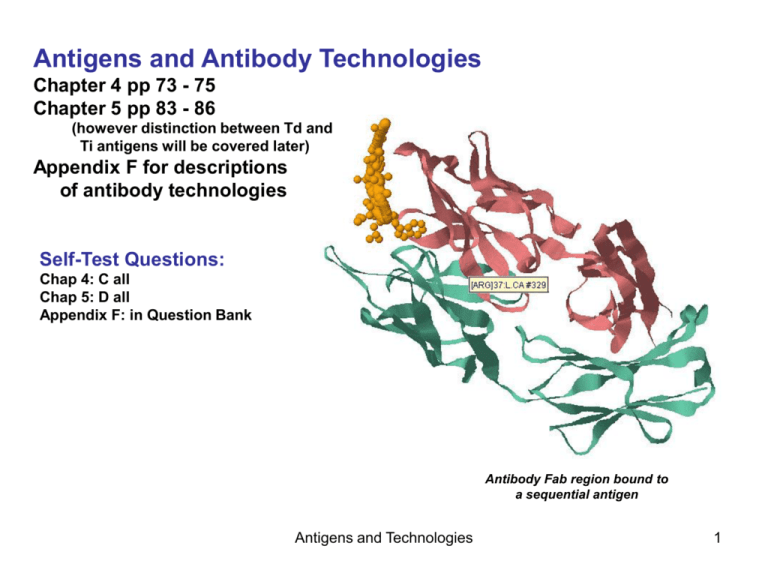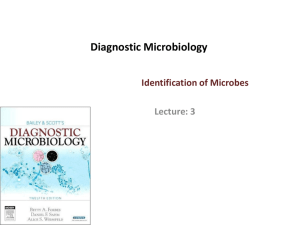5a-antigens and technologies
advertisement

Antigens and Antibody Technologies Chapter 4 pp 73 - 75 Chapter 5 pp 83 - 86 (however distinction between Td and Ti antigens will be covered later) Appendix F for descriptions of antibody technologies Self-Test Questions: Chap 4: C all Chap 5: D all Appendix F: in Question Bank Antibody Fab region bound to a sequential antigen Antigens and Technologies 1 Some pertinent terminology Affinity vs Avidity Affinity – Strength of molecular forces Avidity – Affinity x binding valence (# of binding sites) Antigenicity vs Immunogenicity Antigenicity –> Characteristic of a molecule -- ability to trigger an immune response Immunogenicity –> Characteristic of the host -- ability to respond to an antigen Influenced by: • • • • genetics route of administration dosage tolerance “In a natural infection, invading bacteria and viruses appear as collections of proteins, polysaccharides and other macromolecules to the host’s immune system. Within this collection, there are many immunogens, each inducing its own adaptive immune response.” P 83 Antigens and Technologies 2 What factors influence antigenicity? -- ability to bind to TCR and antibody Key characteristics Chemical complexity Size Foreignness Peptides, glycoproteins, complex carbohydrates, lipids -- not sugars, amino acids, acids, etc What forces hold Antigen to receptor? various non-covalent bonds Image from Goldsby et al Immunolgy 5th ed. Fig 6.1 Antigens and Technologies 3 Receptors do not recognize entire antigenic molecules Epitopes (Binding site of Ab is called the “paratope”) Sequential (linear) (B-cells and T-cells) Conformational (B-cells only) -- destroyed by denaturing Sperm whale myoglobin sequential epitopes CHIPS protein of S. aureus: inhibits leukocyte chemotaxis by blocking C5a receptor (Gustafsson, et al. 2009. BMC Immunol. 10: 1-13.) Antibody models Antigens and Technologies 4 “Haptens” are a special case BSA Important in the study of AB/AG binding Mice injected with Antibodies formed DNP (Not to scale) Hapten (DNP) only None Protein (BSA) only Anti-BSA BSA-DNP Anti-DNP (major) Anti BSA (minor) “Adjuvants” stimulate immunogenicity Provide danger signals Freund’s -- /mycobacterium/oil immersion various TLR ligands Create aggregates/deposits/slow release Alum (aluminium hydroxide gel) – in many vaccines Antigens and Technologies 5 How to prepare antibodies to a single epitope Monoclonal antibodies Monoclonals have same AG-binding specificity Myelomas Hybridomas Uses: Research Cancer detection Drug testing HLA testing on & on & on… McGraw-Hill Monoclonal antibodies Antigens and Technologies 6 Antibodies have many uses: analytical, preparative, diagnostic and therapeutic Some analytical methodologies… Elisa (Enzyme-linked Immunosorbent Assay) Indirect: quantifying antibodies e.g.,: titer of anti-HIV antibodies in serum 1O antibody (in serum) 2O antibody (enzyme-linked) chromogen Sandwich: quantifying antigens (skip ‘Competitive’) -- e.g., amount of GP120 (HIV protein) in serum Rows: different patients Columns: different amounts of serum (2X dilution series) Quantifying results -- use “plate reader” -- “titer” Sumanas Elisa Which patient has the highest titer? Antigens and Technologies 7 Western Blotting To detect proteins in electrophoresed samples 1. Extract proteins 2. Electrophorese 3. Electroblot to nitrocellulose 4. Probe with 1O & 2O Abs why use 2O ab? why use enzyme? 5. Stain Mouse melanoma tissue electrophoresed and probed with anti-actin antibodies A: molecular Wt standards B: stained gel C: probed nitrocellulose Antigens and Technologies 8 Immunohistology Immunofluorescence detection of Herpes Simplex Virus I To look for antigens in histological sections Enzyme-linked antibodies (Immunohistochemistry) or Immunofluorescence indirect is more sensitive… why? Hodgkin’s disease: immunohistochemical staining for Epstein-Barr virus © 2002 Novocastra Laboratories Ltd. Antigens and Technologies 9 Some preparative techniques Immunoprecipitation Affinity Chromatography Antigens and Technologies 10





